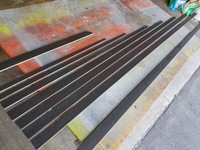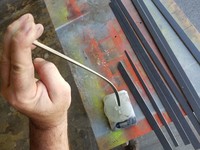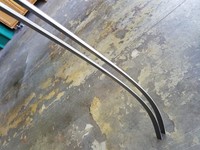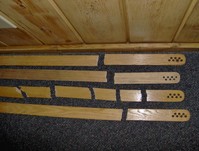How important are sail battens really?
Here's the project of the day. (click for more pictures) Building a set of new batten for the new sail for the year (aka. "The last Henry"). Ice is coming soon, and this is a great last project before the sailing season starts to improve your boat's performance. You don't have to spend a ton on custom battens that you could be making yourself. How important is the correct set of battens? Well, I don't know how much faster they can make you go, but I do know how the wrong battens are guaranteed to slow you down.

Like many sailors, I used to pay little attention to batten matching and stiffness, and just went with the theory that battens just keep the sail from flapping, right?? Seemed to work sort of fine for all the back of the pack boats I owned until I started playing with the little C skeeter. When the new boat was finished, I was running out of time before ice, whipped up a set of tapered, quarter sawn ash battens, never measured stiffness, and went sailing. It was the slowest sailing contraption ever. Eventually in the frustration, I measured stiffness and found the top 4 battens were about 10 times stiffer than they should be. So here's what I can share, but feel free to add to the discussion or point out the error of my ways.
-- Batten stiffness: batten stiffness can completely change a sail. You can turn a "fat bag" into a "flat blade" by going to stiffer battens all the way up the sail. You can completely change the twist of the sail by going to stiffer battens in the top half of the sail only. There are many methods to measure stiffness, but I prefer measuring compression stiffness. See picture below. Rest the batten vertically on the scale. Zero or tare out the weight of the batten. Push on the end of the batten until it deflects out of column. How much it deflects doesn't affect the reading by a lot, but you can simply deflect until it looks like a sail shape. Compression stiffness should range from either being the same for all battens in the sail, or can be varied to be up to 50 percent stiffer near the top. I make them the same all the way up the sail, and then if I want more twist for high winds, I will just exchange the top couple for stiffer battens. What's the "right" stiffness? Beats me, and depends highly on the boat. The lightest I ever run for the little C skeeter is 4 lbs, and the heaviest is about 8 lbs.

-- Bend profile: When deflected, the batten should match sail shape, period. The location of maximum sail draft should very exactly match the point of maximum batten deflection. All battens must be very carefully matched so their profiles are IDENTICAL!! Always try to get the bend profile by sanding the thickness, not the width. If composite, then fine tuning can be done with the width after lamination, but the majority of the work should be in the thickness of the core.

-- Materials, construction and durability: What makes battens such a great project is that the materials to make your own cost next to nothing. You can make a fantastic set of battens out of thin quarter sawn ash. Don't want to spend lots of money or throw it away in the planer? Just take (2) 3/4 x 4 plain sawn ash boards, laminate them together, and just rip them down to 3/16" and start sanding. Given the same stiffness, wide and thin battens are always more durable than narrow and thick. Absolutely never substitute oak for ash, or your battens will last about a day. Composite battens are super easy and super cheap as well. The core can be anything lightweight and shear resistant. I have had great durability success with basswood core and carbon fiber laminate, and haven't broken a single one. The set above is still less than $50 of materials. The core can also be any one of numerous composites like foam or coremat. If you want indestructible, nothing beats fiberglass, period. Not thinking about durability? Here's what happens after ONE bad tack in my old rumble seat A skeeter where the wing mast flogged ONCE in a big wind in below zero conditions.

-- Batten tension in the sail: Most of the skeeter fleet gave up on this game a long time ago with the advent of laminate sails. We just put them in tight and zip tie them in. Although, batten tension is still plenty relevant with the DN and Nite, or any other boat with Dacron. An adjustment of batten tension can have the same effect as changing batten stiffness. If you really want to take good care of your Dacron sail, it should be stored with the batten tension released. Probably overkill for most, but that's what the cool kids do........
